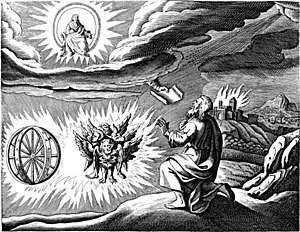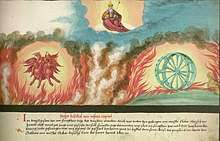Living creatures (Bible)
The living creatures, living beings, or hayyoth (Hebrew חַיּוֹת chayot, from חַיּ chai, "live") are a class of heavenly beings described in the prophet Ezekiel's vision of the heavenly chariot in the first and tenth chapters of the Book of Ezekiel. References to the creatures recur in texts of Second Temple Judaism, in rabbinical merkabah ("chariot") literature, and in the Book of Revelation in the New Testament.



Ezekiel's four living creatures
Ezekiel's vision of the four living creatures in Ezekiel chapter 1 are identified as cherubim in chapter 10[1] who are God's throne bearers.[2] Cherubim as minor guardian deities[3] of temple or palace thresholds are known all over the Ancient East. Each of Ezekiel's cherubim have four faces, that of a man, a lion, a cherub, and an eagle.[2] However, their human shape appearances set them apart from the griffin-like cherubs and lamassu of Babylonia and Assyria. In their ability to move, Ezekiel's cherubim do not need to turn, since they face all compass points simultaneously.[1] This description of movement differs from the seraphim in Isaiah's vision (Isaiah 6:2) who have an extra set of wings for their ability to fly.[4]
Revelation's four living beings
In Revelation 4:6–8, four living beings (Greek: τέσσαρα ζῷα, tessera zō[i]a) are seen in John's vision. These appear as a lion, an ox, a man, and an eagle, much as in Ezekiel but in a different order. They have six wings, whereas Ezekiel's four living creatures are described as only having four. In verse 6, they are said to have "eyes all over, front and back", suggesting that they are alert and knowledgeable, that nothing escapes their notice. The description parallels the wheels that are beside the living creatures in Ezekiel 1.18; 10.12, which are said to be "full of eyes all around". The Hebrew word for "wheel" (ôpannîm) was also used in later Jewish literature to indicate a member of the angelic orders (1 Enoch 71.7; 3 Enoch 1.8; 7.1; 25.5-6, etc.). In this passage in Revelation, the four beasts surround "the one" on the red throne (which is of ruby and sardius), which is contrasted with the white throne in Daniel 7:9 and Revelation 20:11-15.
Comparing the living creatures in Ezekiel with Revelation's is a prominent apocalyptic study in Western Christianity.[5] An example is the 18th Century works of Jonathan Edwards' recorded interpretation of 1722/23.[6] The four living creatures that John of Patmos sees in the Book of Revelation, is the author's reworking of the living creatures in the visions of Ezekiel (Ezekiel 1:5-28)[7] and Isaiah (Isaiah 6:2).[8] William D. Mounce noted a belief that the living creatures may have been associated with the four principal signs of the zodiac,[7] but other scholars have doubted this interpretation.[9]
In a critical analysis of John's vision, April De Conick's 2006 essay outlines that the hayyot in Ezekiel are perhaps not original with the author of Revelation. De Conick suggests that John may have drawn from other merkabah-related texts and by subtly working with images already known to his audience, he reshaped them for his own purposes.[10] With John blending and transforming the images of his sources, it has given way to different interpretations.[7]
Religious views
In Judaism, the living beings are considered angels of fire, who hold up the throne of God and the earth itself.[11] They are ranked first in Maimonides' Jewish angelic hierarchy.
In Christianity, the four living creatures are Cherubim.[3] A prominent early interpretation, variously modified by different interpreters, has been to equate the four creatures as a tetramorph of the Four Evangelists. Throughout church history, the most common interpretation (first laid out by Victorinus), but not the original or the only, is that the lion represents Mark, the calf Luke, the man Matthew, and the eagle John. Irenaeus was the first to make the association with the evangelists, but the interpretation laid out by Victorinus and adopted by Jerome, Gregory the Great, and the Book of Kells became dominant.[12] Its influence has been on art and sculpture[8] and is still prevalent in Catholicism[13] and Anglicanism.[14] A view held by many modern commentators is that the four living creatures of Revelation are agents of God and heavenly representatives of the created order, who call every living thing to worship the Creator.[15] The four living creatures are identified by some scholars as hybrids (see human-animal hybrids).[16] On this interpretation, the creatures merge traits of the world above (six wings; eyes in front and behind and around and inside) with character traits from this world (lion, ox, human, eagle). They represent the world above and this world in complete harmony with its Creator. By contrast, the locusts from the abyss (cf. Rev. 9:3-11) combine traits of the world below with this world and represent the creation in rebellion from its Creator.
See also
References
- Eichrodt 2003, p. 55
- Duguid, Iain M. (2011). Ezekiel: The NIV Application Commentary. Zondervan. ISBN 9780310866107.
- Donald Senior, John J. Collins (2011). Catholic Study Bible-NABRE; See footnote 1:5 "Four living creatures". Oxford University Press. p. 1162. ISBN 9780195297751.
- Eichrodt 2003, p. 57
- Pate, C. Marvin (2009). Reading Revelation: A Comparison of Four Interpretive Translations of the Apocalypse. Kregel Academic. ISBN 9780825433672.
- Kreider, Glenn (2004). Jonathan Edwards' Interpretation of Revelation 4:1-8:1. University Press of America. p. 111. ISBN 9780761826705.
- Smalley, Stephen S. (2012). The Revelation to John: A Commentary on the Greek Text of the Apocalypse. InterVarsity Press. pp. 120–121. ISBN 9780830829248.
- Woodman, Simon P (2008). The Book of Revelation. Hymns Ancient and Modern Ltd. p. 128. ISBN 9780334041047.
- Smalley, Stephen S. (2012). The Revelation to John: A Commentary on the Greek Text of the Apocalypse. InterVarsity Press. p. 120. ISBN 9780830829248.
It is most unlikely that the four living creatures are to be identified with either the four constellations of stars (cf. Charles 1, 123), or the four principal signs of the zodiac (cf. Mounce 124 n. 26).
- De Conick, April D (2006). Paradise Now: Essays on Early Jewish and Christian Mysticism. Society of Biblical Literature. pp. 203–204. ISBN 9781589832572.
- Davidson, Gustav (1967). A Dictionary of Angels, Including The Fallen Angels. Library of Congress Catalog Card Number: 66-19757: Free Press. p. 120. ISBN 9780029070505.CS1 maint: location (link)
- Judith Kovacs, Christopher Rowland (2004). Revelation: The Apocalypse of Jesus Christ. Oxford: Blackwell publishing. p. 66. ISBN 9781405143219.
- Barber, Michael (2005). Coming Soon: Unlocking the Book of Revelation and Applying Its Lessons Today. Emmaus Road Publishing. p. 86. ISBN 9781931018265.
- Stevenson, Kenneth (2001). Biblica, Vol.34: Animal Rites: The Four Living Creatures in Patristic Exegesis and Liturgy. Peeters Publishers. p. 470. ISBN 9789042908819.
- Koester, Craig R. (2014). Revelation. New Haven: Yale University Press. p. 353.
- James L. Resseguie, "A Glossary of New Testament Narrative Criticism with Illustrations," in Religions, 10 (3) 217), 5-6.
External links
| Wikimedia Commons has media related to Living creatures (Bible). |